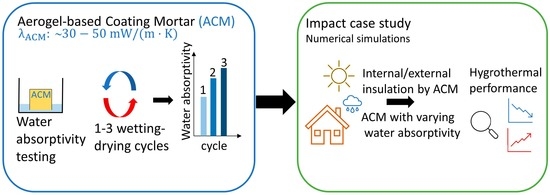Increasing Water Absorptivity of an Aerogel-Based Coating Mortar in Subsequent Wetting and Drying
Abstract
1. Introduction
2. Results and Discussion
2.1. Laboratory Measurements
2.2. Numerical Hygrothermal Simulations
3. Conclusions
4. Materials and Methods
4.1. Laboratory Measurements
4.2. Impact Case Study on a Reference Building: Numerical Hygrothermal Simulations
4.2.1. Reference Building: Örgryte New Church
4.2.2. Multilayer Wall System with ACM
4.2.3. Numerical Hygrothermal Simulations
Author Contributions
Funding
Data Availability Statement
Acknowledgments
Conflicts of Interest
Appendix A
| Scenario | Rain: AFR | Additional Vapor Resistance: Exterior | Brick Type | ACM |
|---|---|---|---|---|
| No | Masonry | NO | ||
| Scenario 0 | 0.7 | No | Extruded | NO |
| No | Historical | NO |
| Material | ρ (kg/m3) | (mW/(m·K)) | µ (−) | 10−11 (m2/s) | 10−8 (m2/s) |
|---|---|---|---|---|---|
| Brick masonry a | 1900 | 600 | 10 | 2.5 | 1.2 |
| Extruded brick a | 1650 | 600 | 9.5 | 5.3 | 4.4 |
| Historical brick a | 1800 | 600 | 15 | 10 | 9.3 |
| Internal coating mortar | 1200 | 820 | 10 | 4.1 | 1.0 |
| Paint c (sd:0.01) | - | - | 50 | - | - |
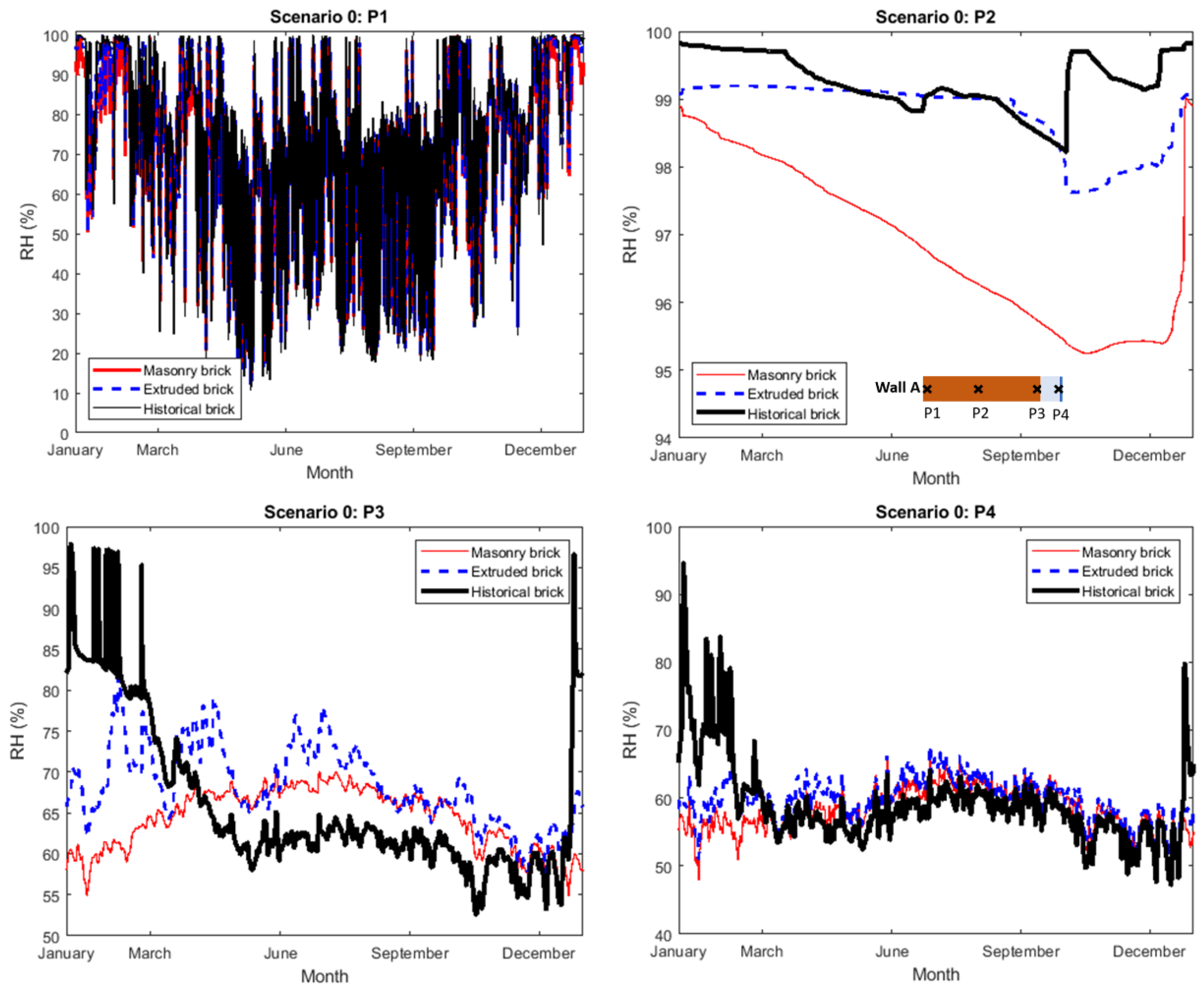
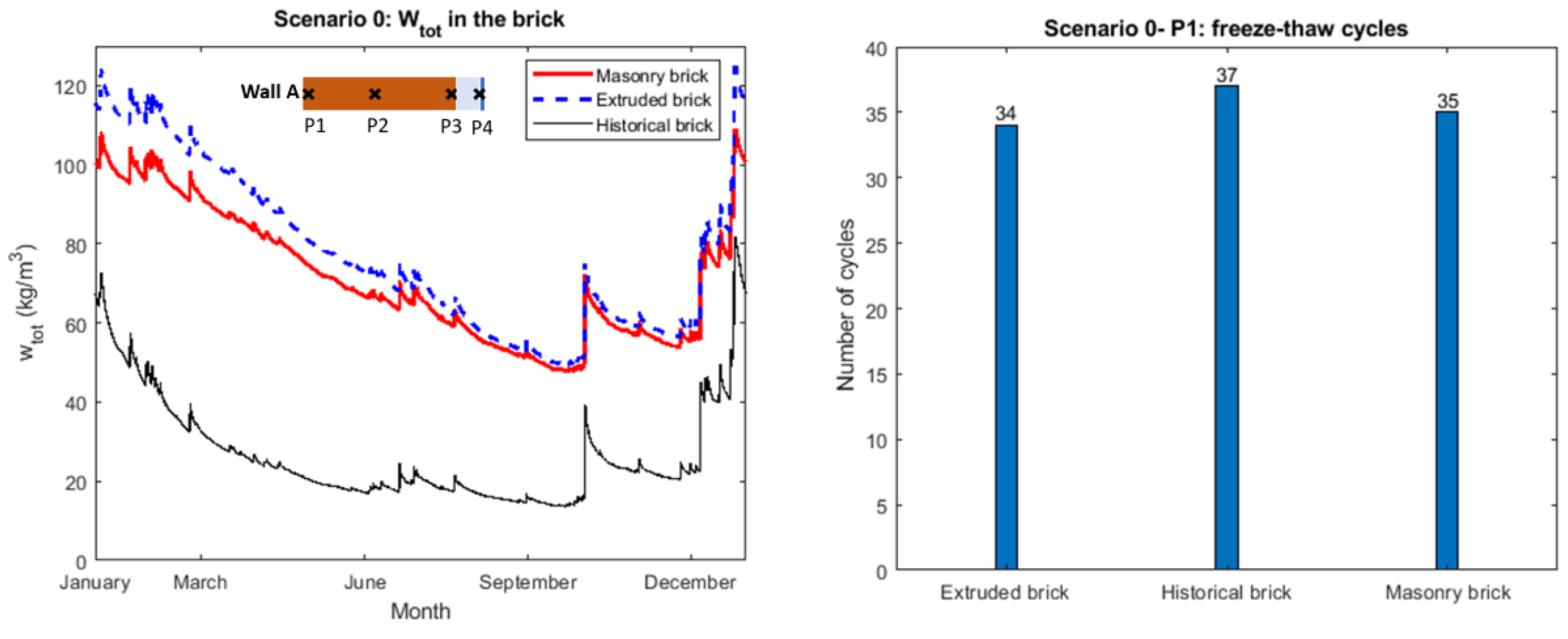
Appendix B

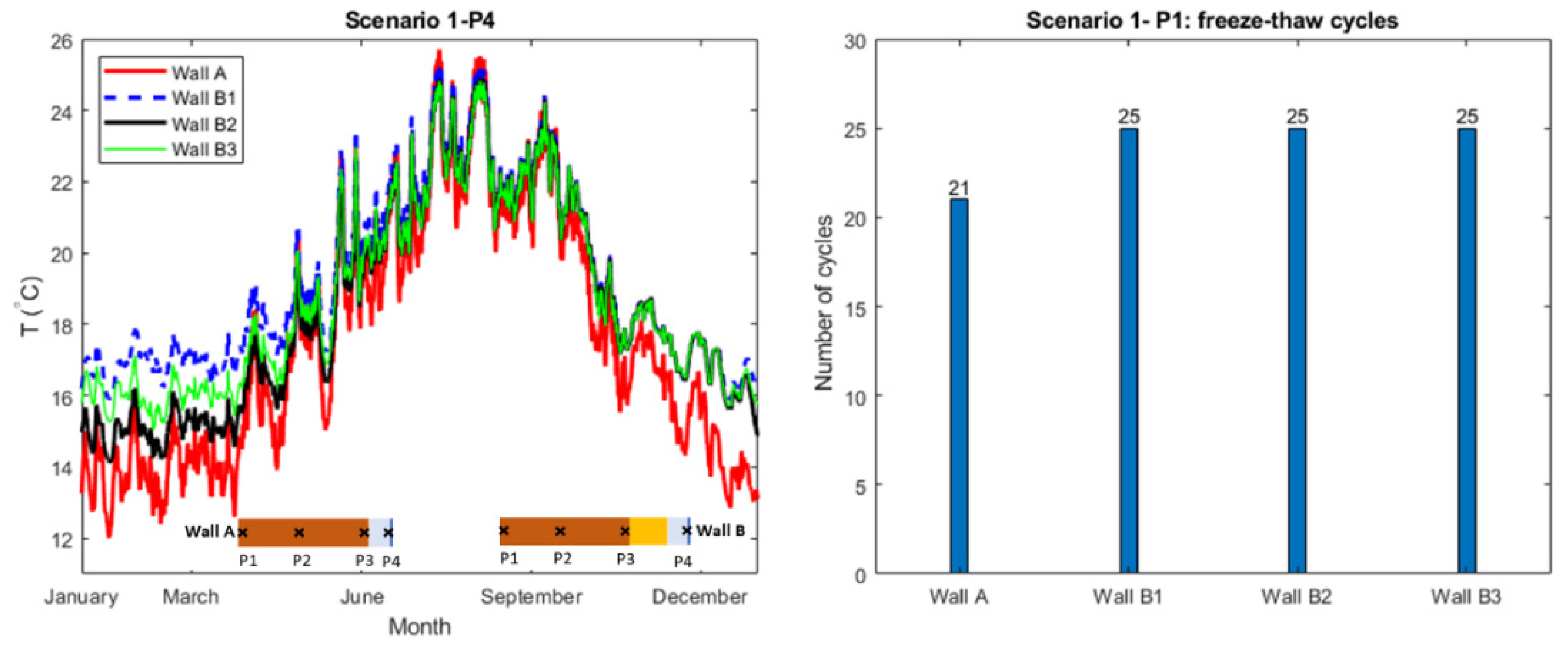
Appendix C
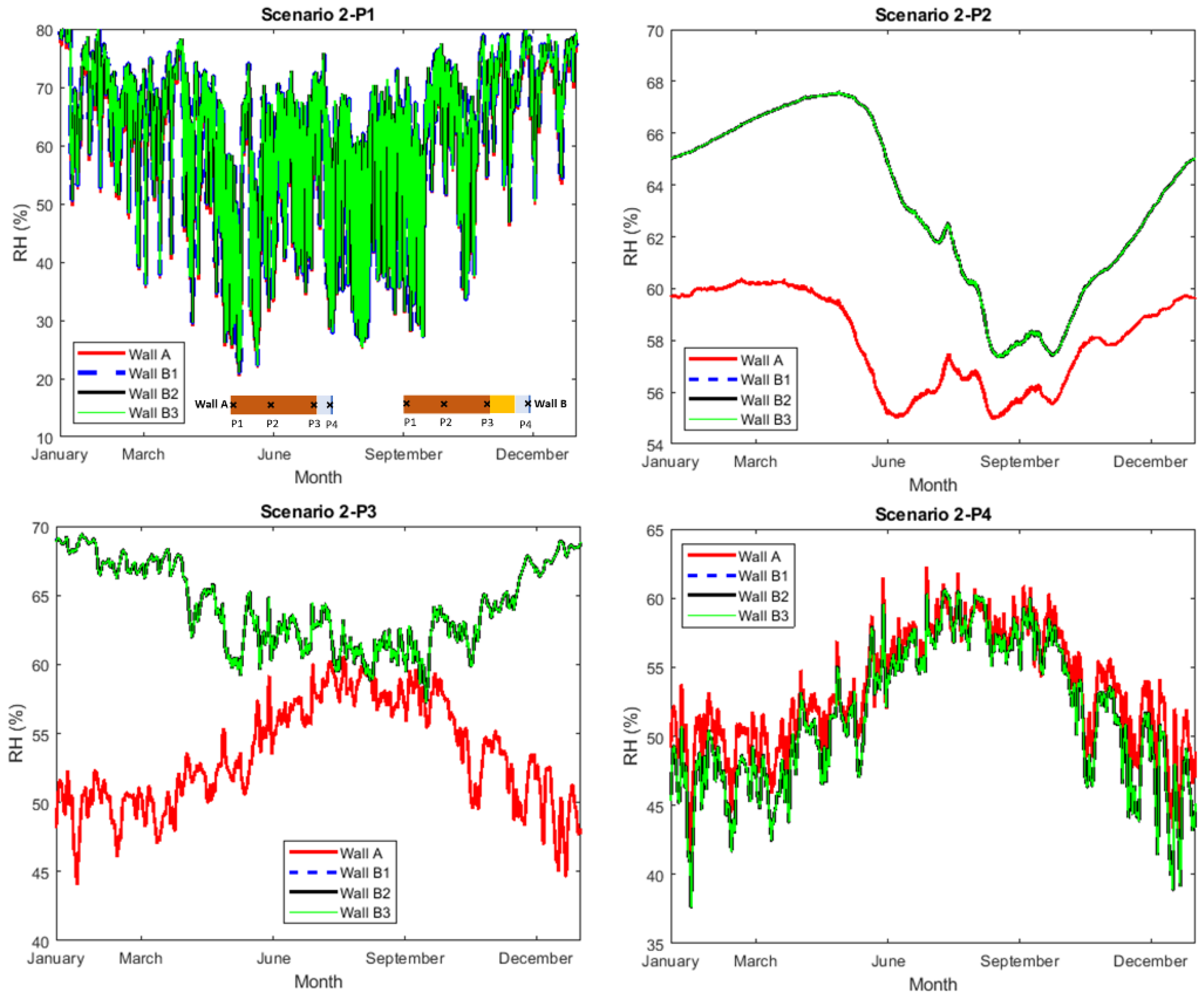
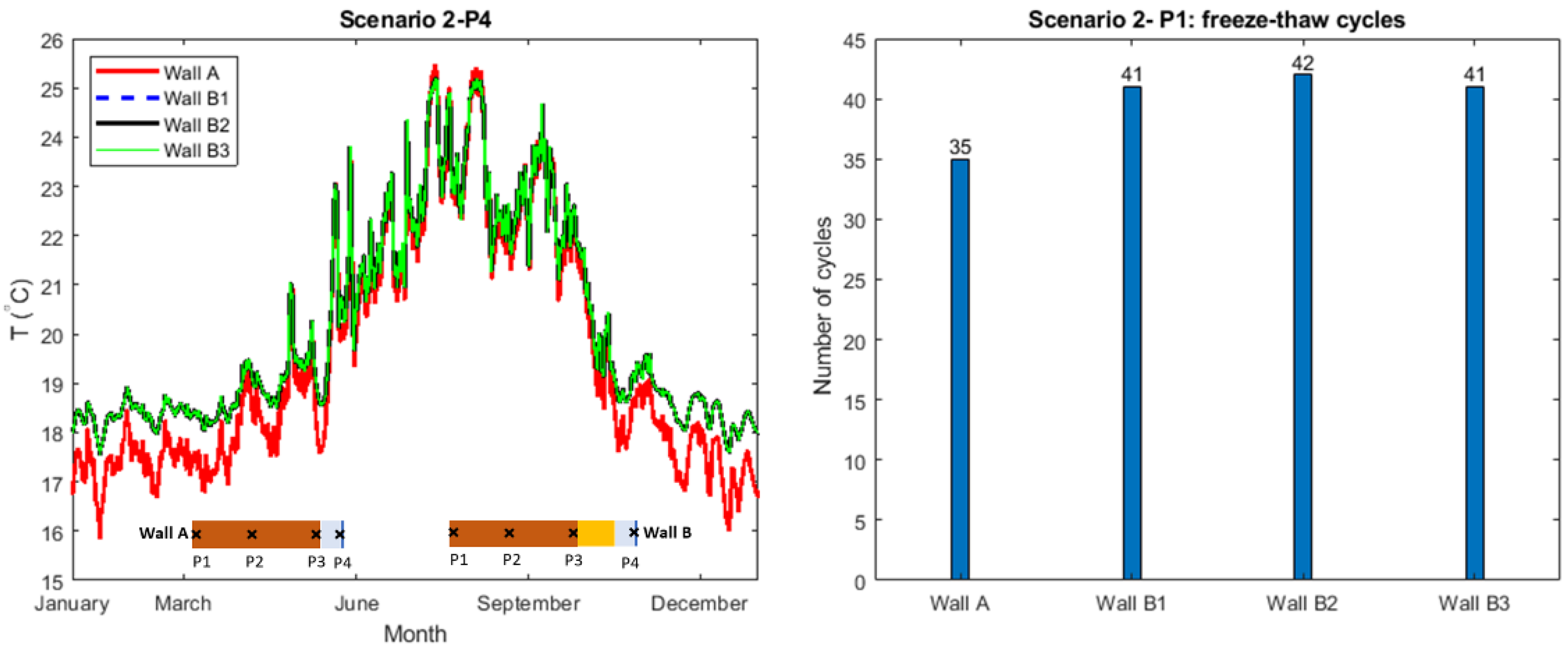
Appendix D
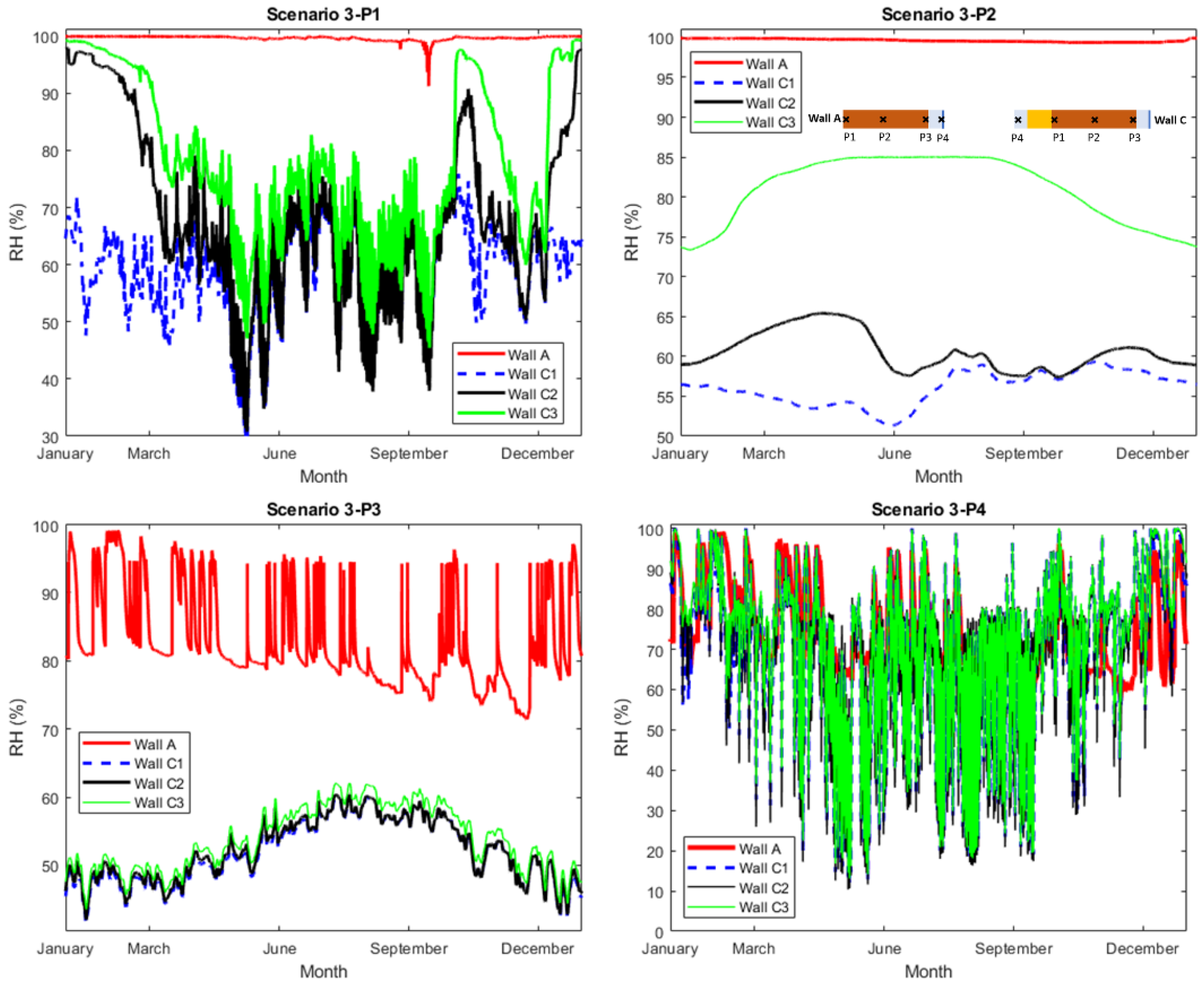
References
- Karim, A.N.; Johansson, P.; Kalagasidis, A.S. Knowledge gaps regarding the hygrothermal and long-term performance of aerogel-based coating mortars. Constr. Build. Mater. 2021, 314, 125602. [Google Scholar] [CrossRef]
- Stahl, T.; Wakili, K.G.; Heiduk, E. Stability Relevant Properties of an SiO2 Aerogel-Based Rendering and Its Application on Buildings. Sustainability 2021, 13, 10035. [Google Scholar] [CrossRef]
- Stahl, T.; Wakili, K.G.; Hartmeier, S.; Franov, E.; Niederberger, W.; Zimmermann, M. Temperature and moisture evolution beneath an aerogel based rendering applied to a historic building. J. Build. Eng. 2017, 12, 140–146. [Google Scholar] [CrossRef]
- Fenoglio, E.; Fantucci, S.; Perino, M.; Serra, V.; Dutto, M.; Marino, V. Energy retrofit of residential buildings with a novel super-insulating aerogel-based plaster. AiCARR J. 2020, 61, 44–48. [Google Scholar]
- Frick, J.; Sakiyama, N.R.M.; Stipetic, M.; Garrecht, H. Large Scale Laboratory and Field Tests of Aerogel Renders. In Proceedings of the XV International Conference on Durability of Building Materials and Components—DBMC 2020, Barcelona, Spain, 20–23 October 2020. [Google Scholar] [CrossRef]
- Sakiyama, N.R.M.; Frick, J.; Stipetic, M.; Oertel, T.; Garrecht, H. Hygrothermal performance of a new aerogel-based insulating render through weathering: Impact on building energy efficiency. Build. Environ. 2021, 202, 108004. [Google Scholar] [CrossRef]
- Maia, J.; Pedroso, M.; Ramos, N.M.M.; Flores-Colen, I.; Pereira, P.F.; Silva, L. Durability of a New Thermal Aerogel-Based Rendering System under Distinct Accelerated Aging Conditions. Materials 2021, 14, 5413. [Google Scholar] [CrossRef] [PubMed]
- Karim, A.N. Aerogel-Based Plasters for Renovation of Buildings in Sweden: Identification of Possibilities, Information Deficiencies and Challenges. Licentiate Thesis, Chalmers University of Technology, Göteborg, Sweden, 2021. [Google Scholar]
- Cornick, S.M.; Lacasse, M.A. A Review of Climate Loads Relevant to Assessing the Watertightness Performance of Walls, Windows, and Wall-Window Interfaces. J. ASTM Int. 2005, 2, 1–16. [Google Scholar] [CrossRef]
- Geving, S.; Erichsen, T.H.; Nore, K.; Time, B. Hygrothermal Conditions in Wooden Claddings—Test House Measurements; Project report 407—2006; Norwegian Building Research Institute: Oslo, Norway, 2006. [Google Scholar]
- Lacasse, M. Recent Studies on the Control of Rain Penetration in Exterior Wood-Frame Walls; National Research Council Canada: Ottawa, ON, Canada, 2003. [Google Scholar]
- Samuelson, I.; Mjörnell, K.; Jansson, A. Moisture damage in rendered, undrained, well insulated stud walls. In Third International Symposium on Tunnel Safety; Danish Society of Engineers, IDA: Copenhagen, Denmark, 2008. [Google Scholar]
- Lacasse, M.A.; Miyauchi, H.; Hiemstra, J.; Wolf, A.T.; Dean, S.W. Water Penetration of Cladding Components—Results from Laboratory Tests on Simulated Sealed Vertical and Horizontal Joints of Wall Cladding. J. ASTM Int. 2009, 6, 1–29. [Google Scholar] [CrossRef]
- Kottek, M.; Grieser, J.; Beck, C.; Rudolf, B.; Rubel, F. World map of the Köppen-Geiger climate classification updated. Meteorol. Z. 2006, 15, 259–263. [Google Scholar] [CrossRef] [PubMed]
- EN 998-1; Specification for Mortar for Masonry—Part 1: Rendering and Plastering Mortar. European Committee for Standardization (CEN): Brussels, Belgium, 2016.
- EN 1015-18; Methods of Test for Mortar for Masonry—Part 18: Determination of Water Absorption Coefficient due to Capillary Action of Hardened Mortar. European Committee for Standardization (CEN): Brussels, Belgium, 2002.
- De Fátima Júlio, M.; Soares, A.; Ilharco, L.M.; Flores-Colen, I.; de Brito, J. Aerogel-based renders with lightweight aggregates: Correlation between molecular/pore structure and performance. Constr. Build. Mater. 2016, 124, 485–495. [Google Scholar] [CrossRef]
- Pedroso, M.; Flores-Colen, I.; Silvestre, J.D.; Gomes, M.G.; Silva, L.; Sequeira, P.; de Brito, J. Characterisation of a multilayer external wall thermal insulation system. Application in a Mediterranean climate. J. Build. Eng. 2020, 30, 101265. [Google Scholar] [CrossRef]
- Soares, A.; De Fátima Júlio, M.; Flores-Colen, I.; Ilharco, L.M.; De Brito, J. EN 998-1 performance requirements for thermal aerogel-based renders. Constr. Build. Mater. 2018, 179, 453–460. [Google Scholar] [CrossRef]
- Flores-Colen, I.; Pedroso, M.; Soares, A.; Gomes, M.D.G.; Ramos, N.M.; Maia, J.; Sousa, R.; Sousa, H.; Silva, L. In-Situ Tests on Silica Aerogel-Based Rendering Walls. In Proceedings of the XV International Conference on Durability of Building Materials and Components—DBMC 2020, Barcelona, Spain, 20–23 October 2020. [Google Scholar] [CrossRef]
- Maia, J.; Pedroso, M.; Ramos, N.M.M.; Pereira, P.F.; Flores-Colen, I.; Gomes, M.G.; Silva, L. Hygrothermal performance of a new thermal aerogel-based render under distinct climatic conditions. Energy Build. 2021, 243, 111001. [Google Scholar] [CrossRef]
- Pedroso, M.; Flores-Colen, I.; Silvestre, J.; Gomes, M.; Silva, L.; Ilharco, L. Physical, mechanical, and microstructural characterisation of an innovative thermal insulating render incorporating silica aerogel. Energy Build. 2020, 211, 109793. [Google Scholar] [CrossRef]
- Ibrahim, M.; Wurtz, E.; Biwole, P.H.; Achard, P.; Sallee, H. Hygrothermal performance of exterior walls covered with aerogel-based insulating rendering. Energy Build. 2014, 84, 241–251. [Google Scholar] [CrossRef]
- Berardi, U.; Nosrati, R.H. Long-term thermal conductivity of aerogel-enhanced insulating materials under different laboratory aging conditions. Energy 2018, 147, 1188–1202. [Google Scholar] [CrossRef]
- Nosrati, R.; Berardi, U. Long-term performance of aerogel-enhanced materials. Energy Procedia 2017, 132, 303–308. [Google Scholar] [CrossRef]
- Morgado, A.; Soares, A.; Flores-Colen, I.; Veiga, M.; Gomes, M. Durability of Thermal Renders with Lightweight and Thermal Insulating Aggregates: Regranulated Expanded Cork, Silica Aerogel and Expanded Polystyrene. Gels 2021, 7, 35. [Google Scholar] [CrossRef]
- Chen, Y.; Tang, L.; Gao, J.; Punkki, J. The Surface Moisture Transport Model for Cement Mortar Under Dry-Wet Cycles. Electron J. 2018, 1–22. [Google Scholar] [CrossRef]
- Zhou, X.; Carmeliet, J.; Derome, D. Influence of envelope properties on interior insulation solutions for masonry walls. Build. Environ. 2018, 135, 246–256. [Google Scholar] [CrossRef]
- Guizzardi, M.; Carmeliet, J.; Derome, D. Risk analysis of biodeterioration of wooden beams embedded in internally insulated masonry walls. Constr. Build. Mater. 2015, 99, 159–168. [Google Scholar] [CrossRef]
- Wall Systems. HECK AERO iP 2022. Available online: https://www.wall-systems.com/produkte/daemmputze-innendaemmung/aero-ip (accessed on 23 October 2022).
- METTLER TOLEDO. PG503-S DeltaRange—Overview—METTLER TOLEDO n.d. Available online: https://www.mt.com/us/en/home/phased_out_products/others/PG503-S_DR.html (accessed on 22 August 2022).
- Balksten, K.; Lange, J.; Lindholm, M. Fuktproblem i Salt-Och Frostskadat Tegelmurverk-Fördjupad Analys av Örgryte nya Kyrka; Göteborgs Stift: Göteborg, Sweden, 2012. [Google Scholar]
- Fraunhofer IBP. WUFI 2020. Available online: https://wufi.de/en/ (accessed on 20 July 2022).
- Künzel, H.M. Simultaneous Heat and Moisture Transport in Building Components: One- and Two-Dimensional Calculation Using Simple Parameters; Fraunhofer IRB Verlag: Suttgart, Germany, 1995. [Google Scholar]
- Geving, S.; Holme, J. Vapour retarders in wood frame walls and their effect on the drying capability. Front. Archit. Res. 2013, 2, 42–49. [Google Scholar] [CrossRef]
- EN 15026; Hygrothermal Performance of Building Components and Building Elements—Assessment of Moisture Transfer by Numerical Simulation. European Committee for Standardization (CEN): Brussels, Belgium, 2007.
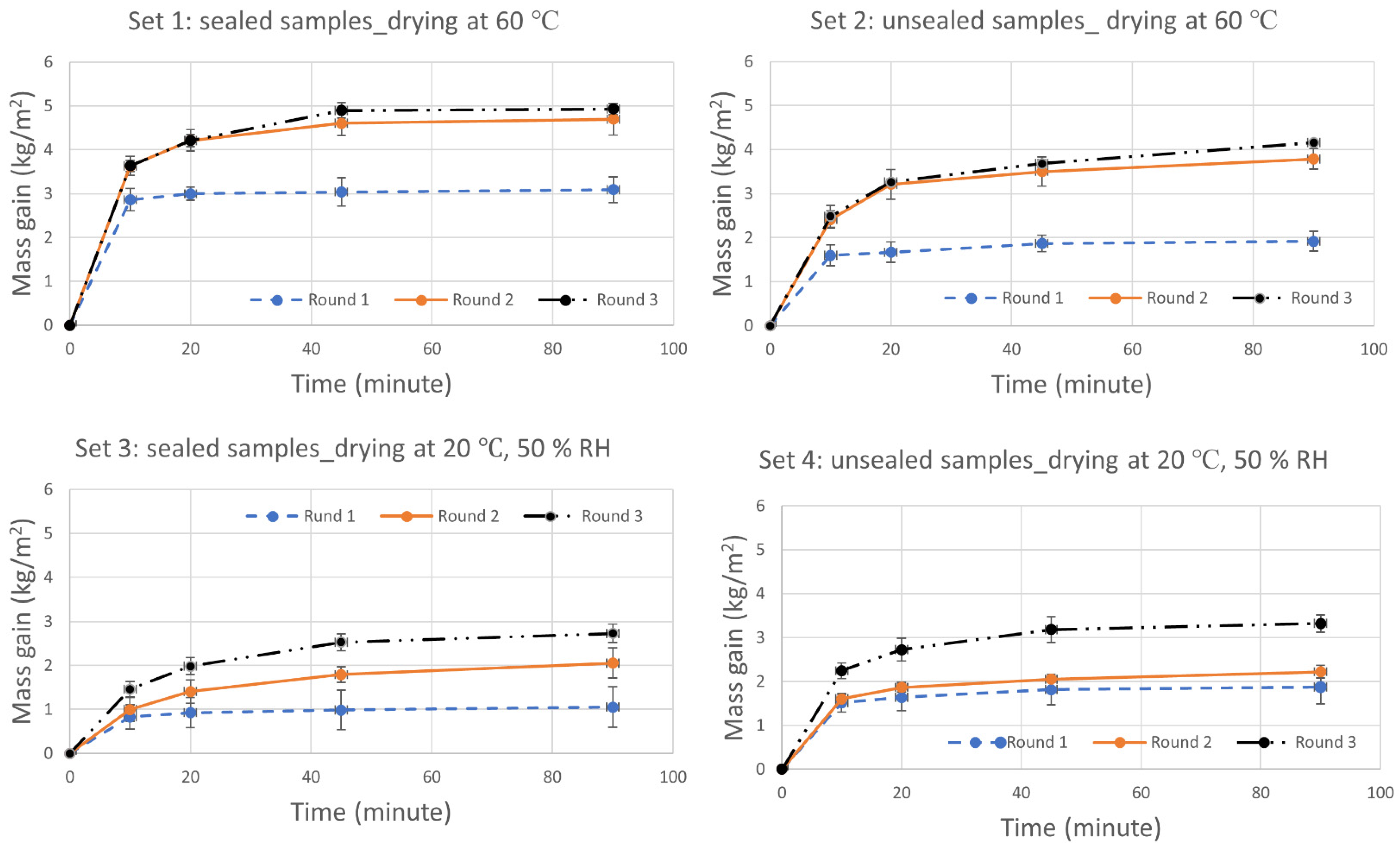
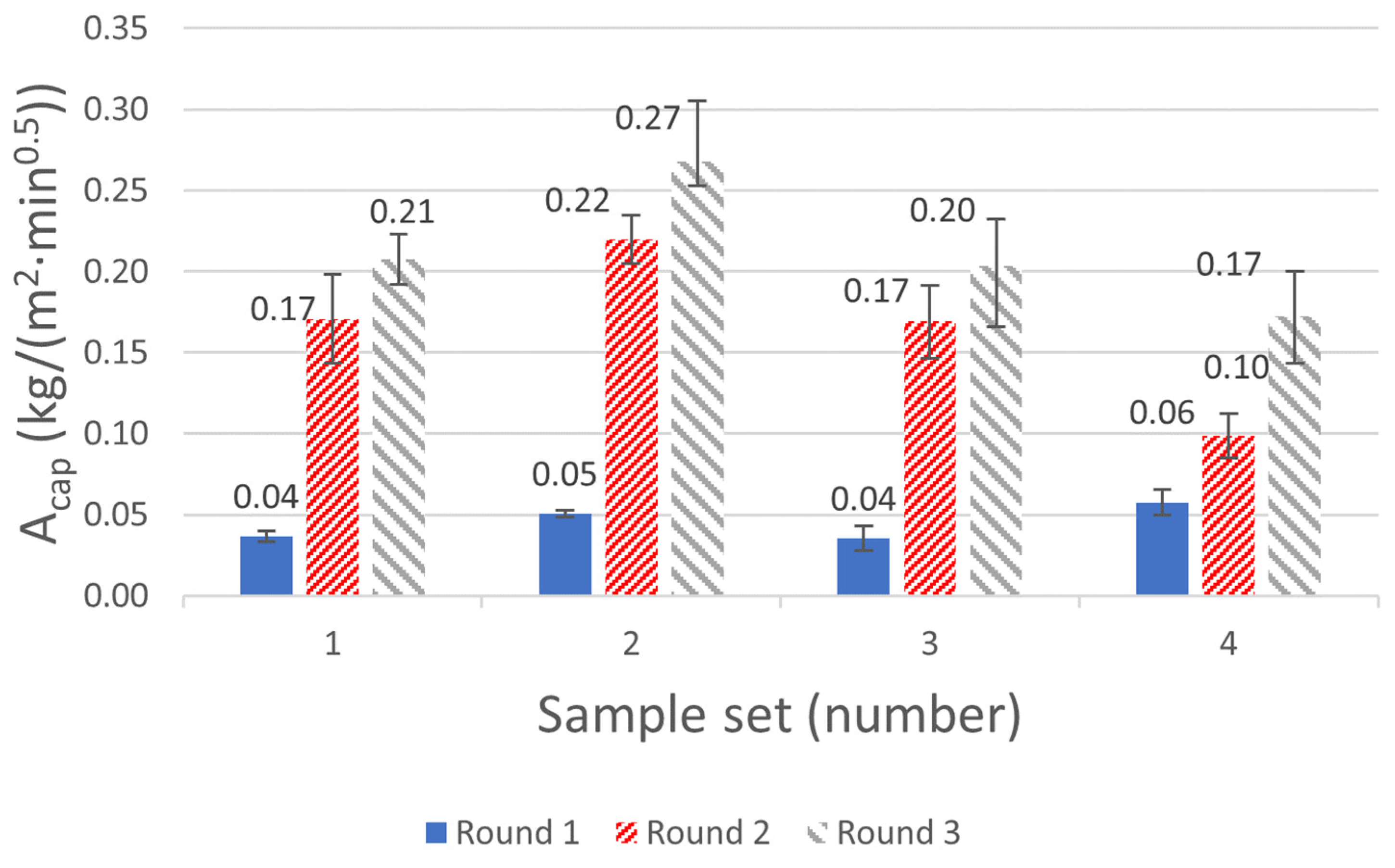
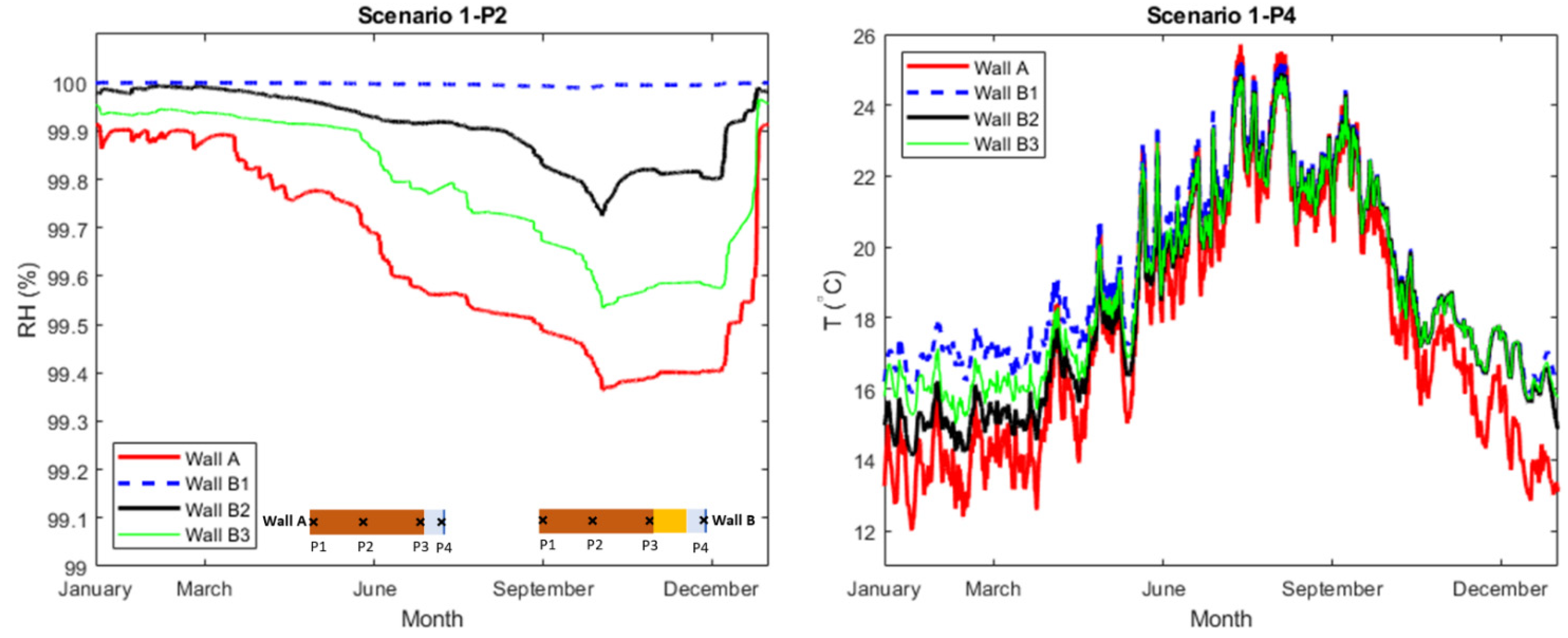

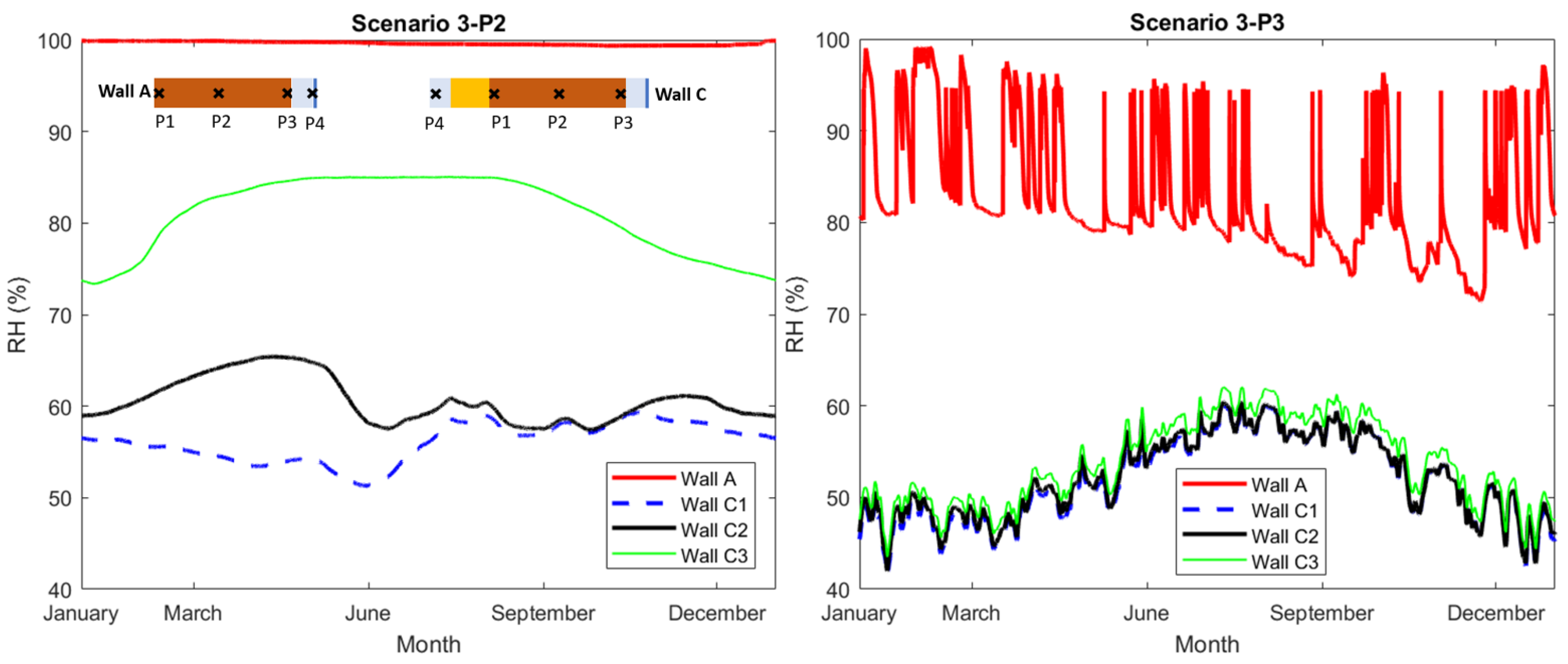

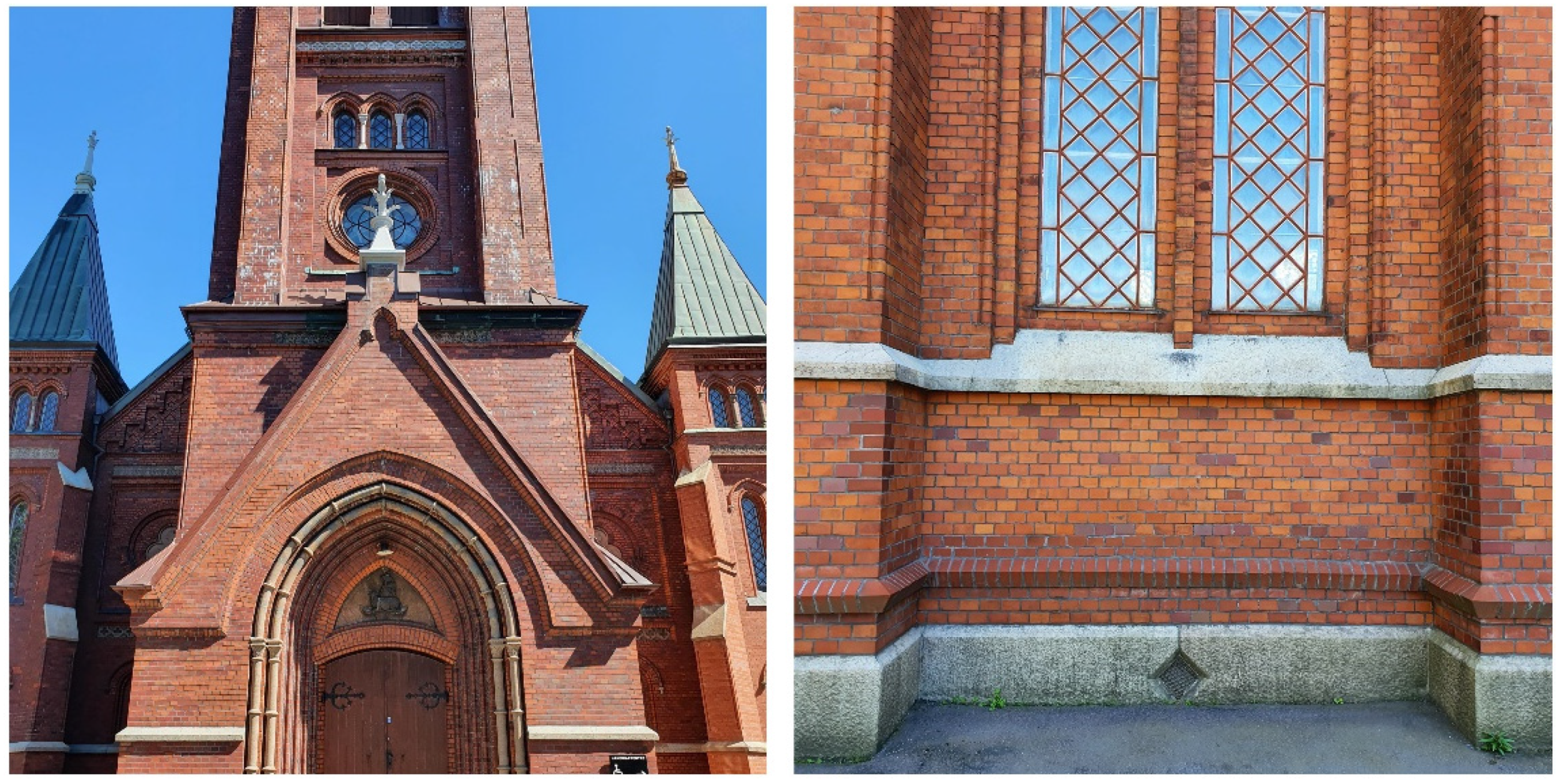
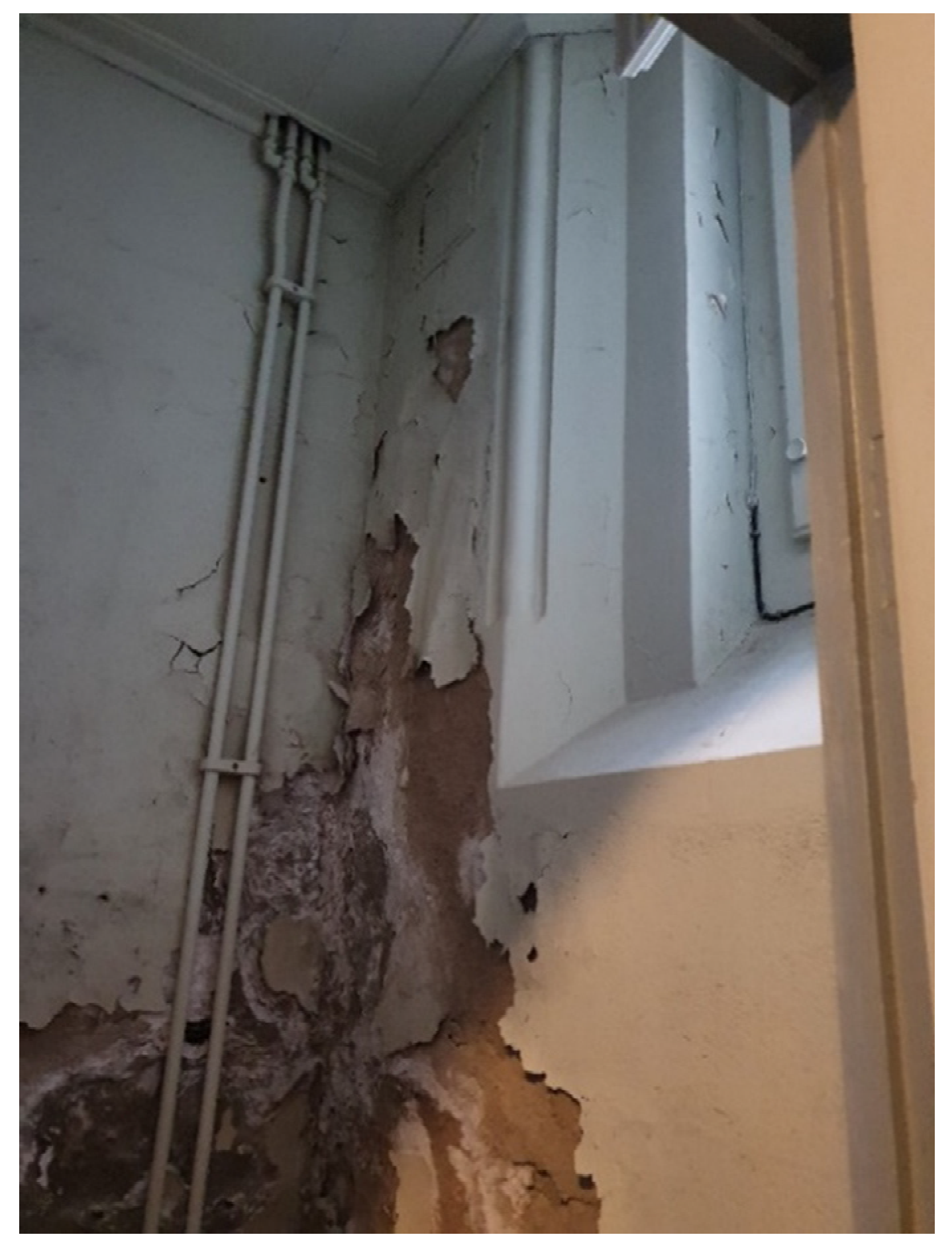
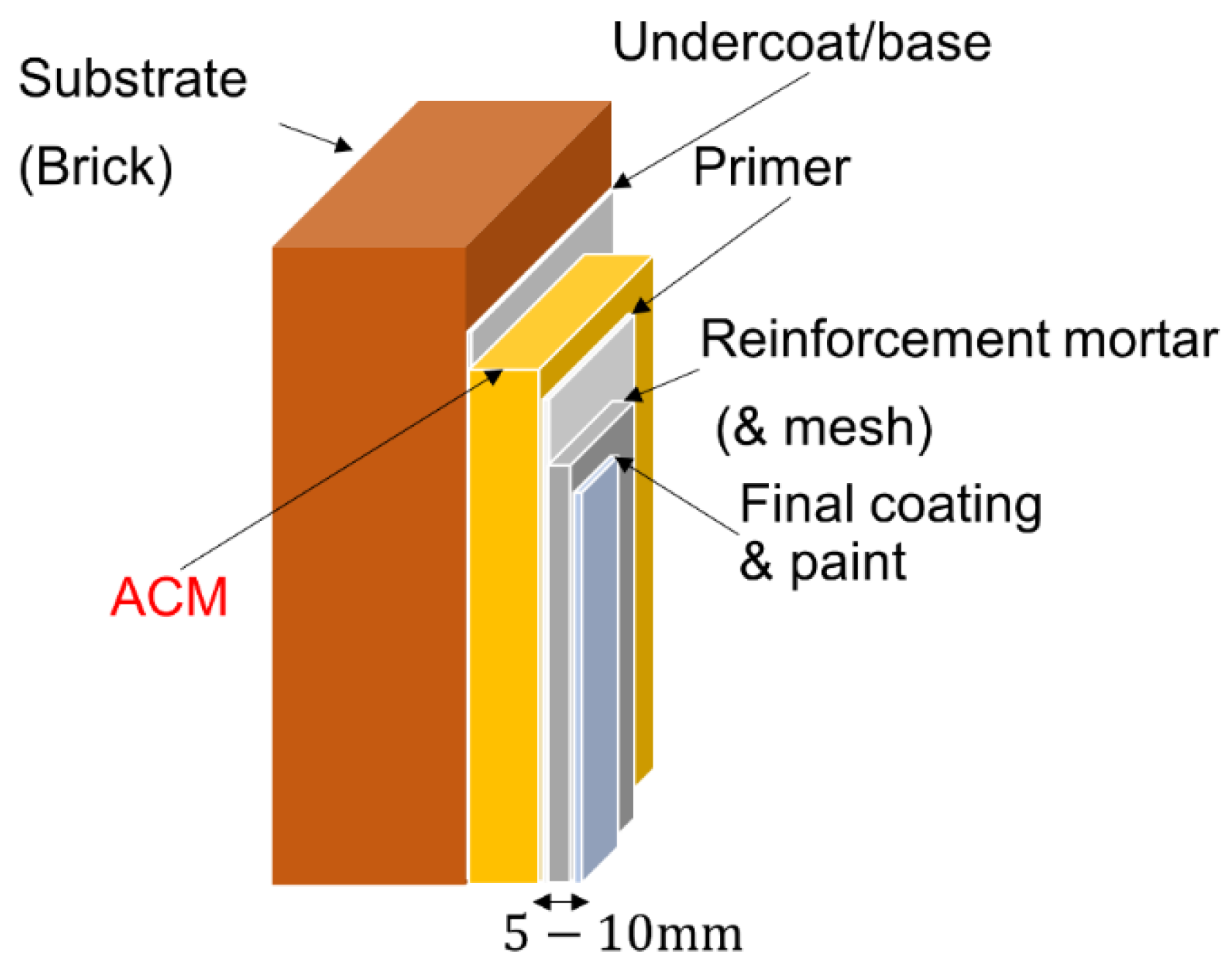
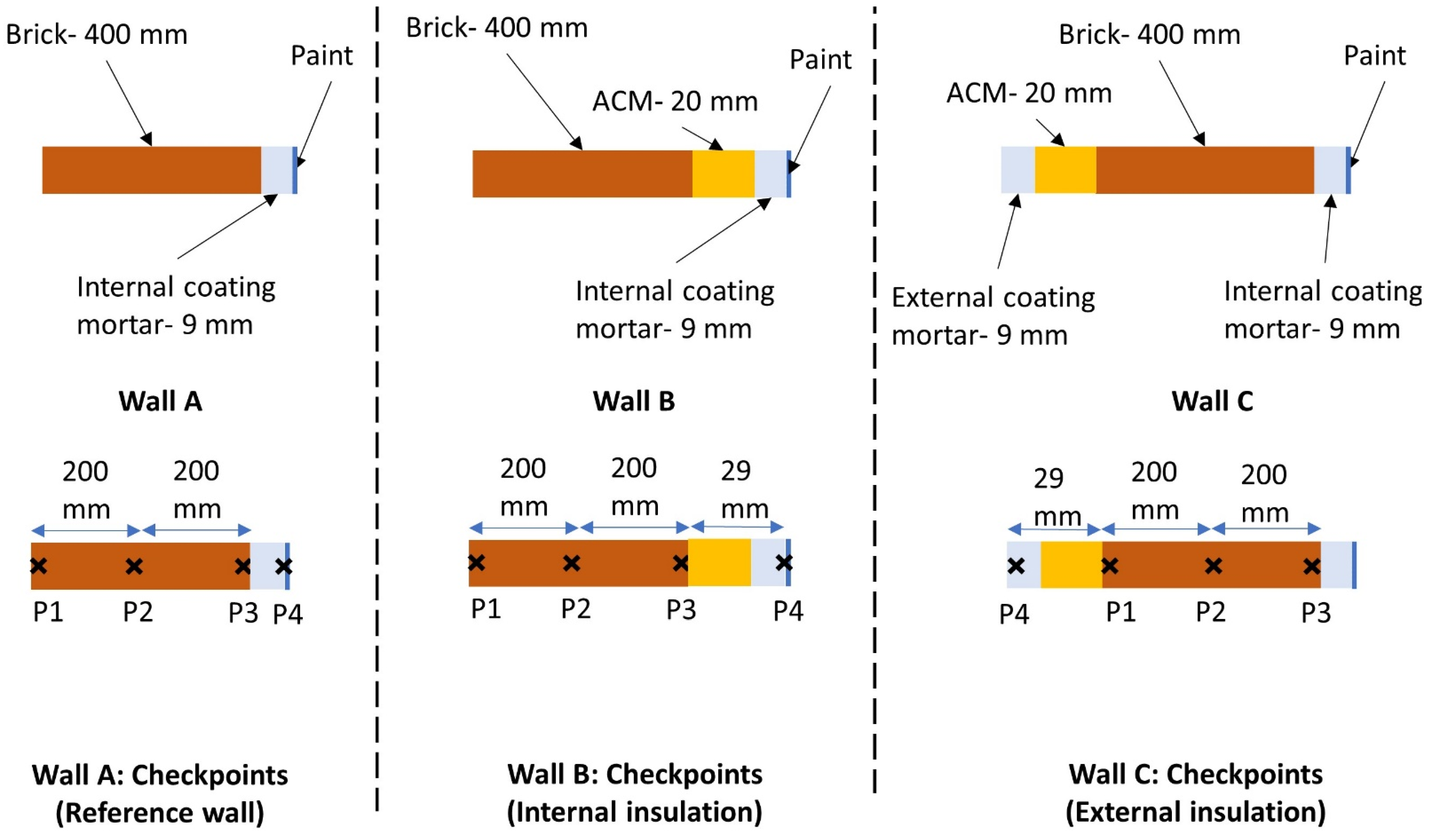

| P1 | P2 | P3 | P4 | |
|---|---|---|---|---|
| Wall A | 99 | 99 | 83 | 74 |
| Wall B1 | 99 | 99 | 99 | 59 |
| Wall B2 | 99 | 99 | 99 | 73 |
| Wall B3 | 99 | 99 | 99 | 72 |
| Maximum variation B1–B3 (%) | 0 | 0 | 0 | 21 |
| P1 | P2 | P3 | P4 | |
|---|---|---|---|---|
| Wall A | 62 | 58 | 53 | 53 |
| Wall B1 | 62 | 63 | 64 | 52 |
| Wall B2 | 63 | 63 | 64 | 52 |
| Wall B3 | 62 | 63 | 64 | 52 |
| Maximum variation B1–B3 (%) | 2 | 0 | 0 | 0 |
| P1 | P2 | P3 | P4 | |
|---|---|---|---|---|
| Wall A | 99 | 99 | 83 | 74 |
| Wall B1 | 57 | 56 | 52 | 71 |
| Wall B2 | 69 | 61 | 52 | 71 |
| Wall B3 | 78 | 81 | 54 | 72 |
| Maximum variation B1–B3 (%) | 31 | 36 | 4 | 1 |
| Property | Unit | Declared Value |
|---|---|---|
| Bulk Density (ρ) | (kg/m3) | 180 |
| Thermal conductivity (λ) | mW/(m·K) | 40 |
| Water vapor permeability coefficient (µ-value) | - | ≤5 |
| Water absorption coefficient (Acap) | kg/(m2·min0.5) | 0.2 (W2) |
| Compressive strength (σc) | N/mm2 | 0.5 (CS I) |
| Dynamic modulus of elasticity (Edyn) | N/mm2 | <100 |
| Sample Set | Number of Samples | Sample Size | Drying Condition | Edge Condition | Number of Testing Rounds/Duration |
|---|---|---|---|---|---|
| 1 | 3 | 100 × 100 × 100 mm3 | 60 °C | Sealed | 3 rounds/90 min |
| 2 | 3 | 100 × 100 × 100 mm3 | 60 °C | unsealed | 3 rounds/90 min |
| 3 | 3 | 100 × 100 × 100 mm3 | 20 °C (50% RH) | Sealed | 3 a rounds/90 min |
| 4 | 3 | 100 × 100 × 100 mm3 | 20 °C (50% RH) | unsealed | 3 rounds/90 min |
| Material | ρ (kg/m3) | (mW/(m·K)) | µ (−) | 10−11 (m2/s) | 10−8 (m2/s) |
|---|---|---|---|---|---|
| Extruded brick a | 1650 | 600 | 9.5 | 5.3 | 4.4 |
| Additional vapor resistance a,b (sd:0.1 m) | - | - | 1000 | - | - |
| Internal coating mortar | 1200 | 820 | 10 | 4.1 | 1.0 |
| Paint c (sd:0.01) | - | - | 50 | - | - |
| ACM-1 | 181 | 40 | 5 | 0.05 | 0.04 |
| ACM-2 | 181 | 40 | 5 | 1.2 | 1.1 |
| ACM-3 | 181 | 40 | 5 | 5.2 | 4.4 |
| Scenario | Rain: AFR | Wall A | Wall B (B1, B2, B3) | Wall C (C1, C2, C3) | Additional Vapor Resistance: Exterior | ACM |
|---|---|---|---|---|---|---|
| Sd = 0.1 m | ACM-1 | |||||
| Scenario 1 | 0.7 | Yes | Yes | No | Sd = 0.1 m | ACM-2 |
| Sd = 0.1 m | ACM-3 | |||||
| Sd = 0.1 m | ACM-1 | |||||
| Scenario 2 | 0 | Yes | Yes | No | Sd = 0.1 m | ACM-2 |
| Sd = 0.1 m | ACM-3 | |||||
| Sd = 0.1 m a | ACM-1 | |||||
| Scenario 3 | 0.7 | Yes | No | Yes | Sd = 0.1 m a | ACM-2 |
| Sd = 0.1 m a | ACM-3 |
| Exterior heat transfer coefficient | 25 W/m2·K |
| Interior heat transfer coefficient | 8 W/m2·K |
| Initial condition | 8.8 °C, 74% RH a |
| Short-wave radiation absorptivity | 0.68 |
| Long-wave radiation emissivity | 0.9 |
| Orientation | South b |
| Adhering fraction of rain | 0.7, 0 |
| Indoor climate | ISO EN 15026: Normal moisture load |
| Maximum temperature (°C) | 27.8 | Maximum relative humidity (%) | 94 |
| Average temperature (°C) | 8.8 | Average relative humidity (%) | 74 |
| Minimum temperature (°C) | −12.2 | Minimum relative humidity (%) | 19 |
| Average wind a (m/s) | 2.97 | Accumulated rain load (mm/year) | 1074 |
Publisher’s Note: MDPI stays neutral with regard to jurisdictional claims in published maps and institutional affiliations. |
© 2022 by the authors. Licensee MDPI, Basel, Switzerland. This article is an open access article distributed under the terms and conditions of the Creative Commons Attribution (CC BY) license (https://creativecommons.org/licenses/by/4.0/).
Share and Cite
Karim, A.N.; Johansson, P.; Sasic Kalagasidis, A. Increasing Water Absorptivity of an Aerogel-Based Coating Mortar in Subsequent Wetting and Drying. Gels 2022, 8, 764. https://doi.org/10.3390/gels8120764
Karim AN, Johansson P, Sasic Kalagasidis A. Increasing Water Absorptivity of an Aerogel-Based Coating Mortar in Subsequent Wetting and Drying. Gels. 2022; 8(12):764. https://doi.org/10.3390/gels8120764
Chicago/Turabian StyleKarim, Ali Naman, Pär Johansson, and Angela Sasic Kalagasidis. 2022. "Increasing Water Absorptivity of an Aerogel-Based Coating Mortar in Subsequent Wetting and Drying" Gels 8, no. 12: 764. https://doi.org/10.3390/gels8120764
APA StyleKarim, A. N., Johansson, P., & Sasic Kalagasidis, A. (2022). Increasing Water Absorptivity of an Aerogel-Based Coating Mortar in Subsequent Wetting and Drying. Gels, 8(12), 764. https://doi.org/10.3390/gels8120764







